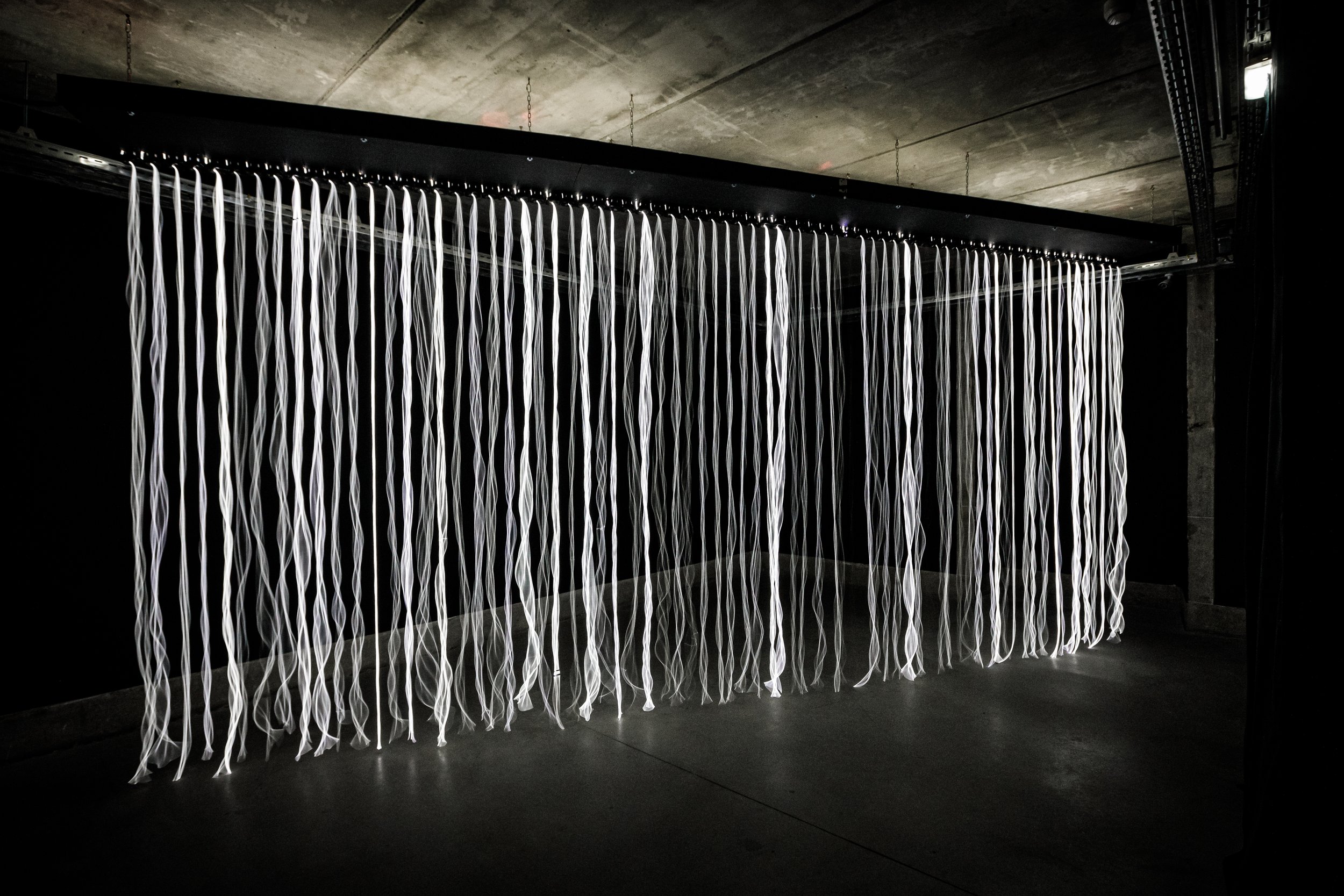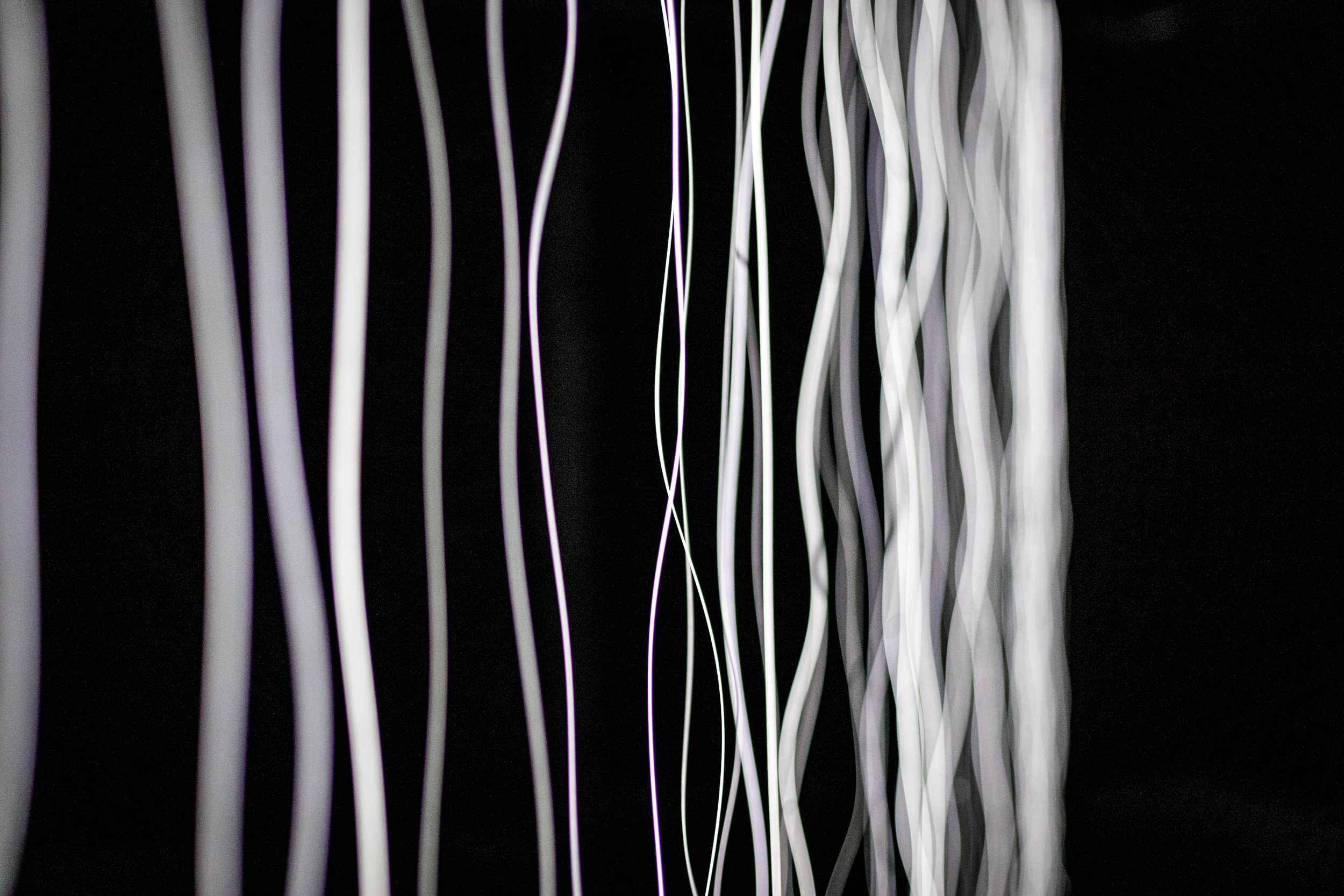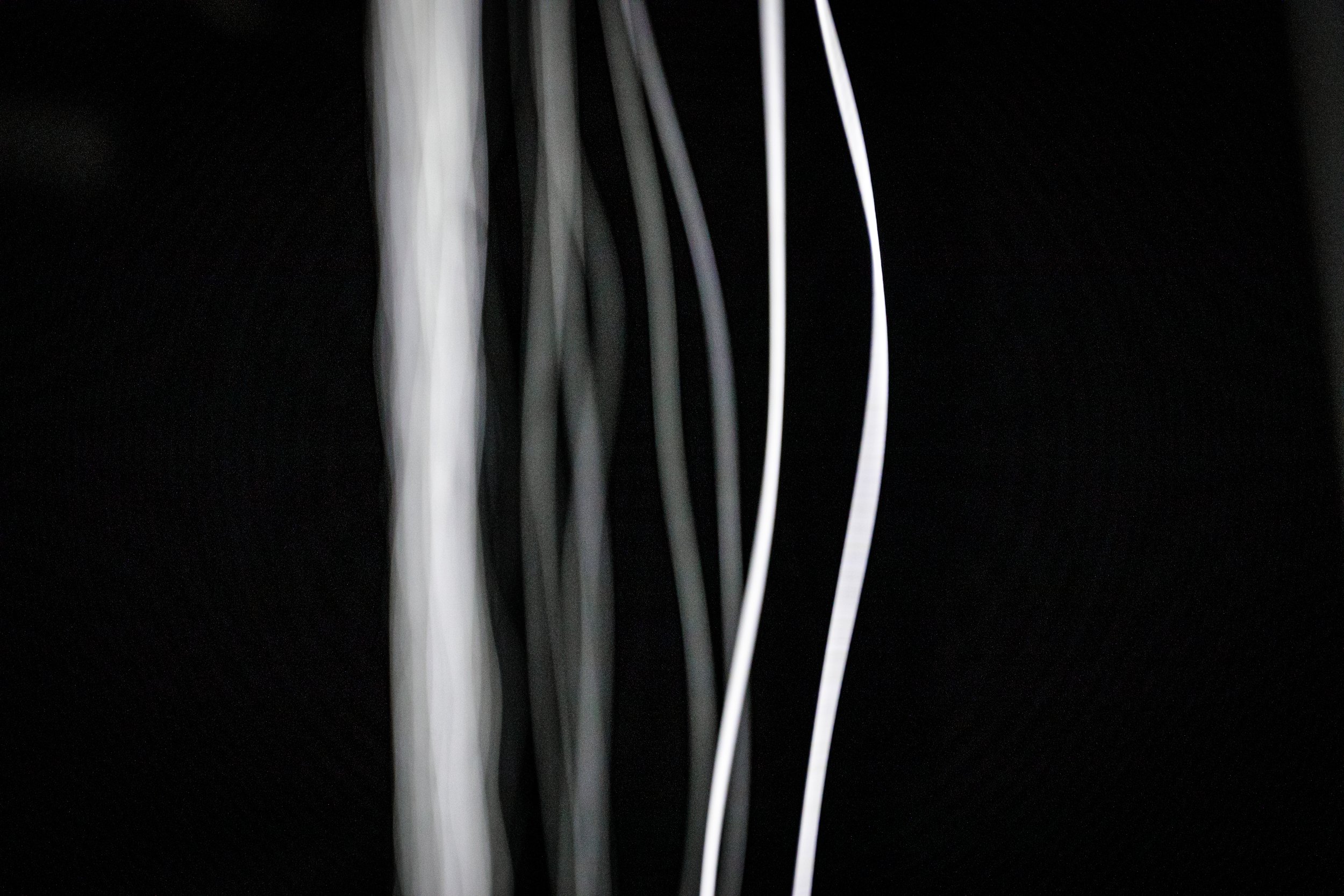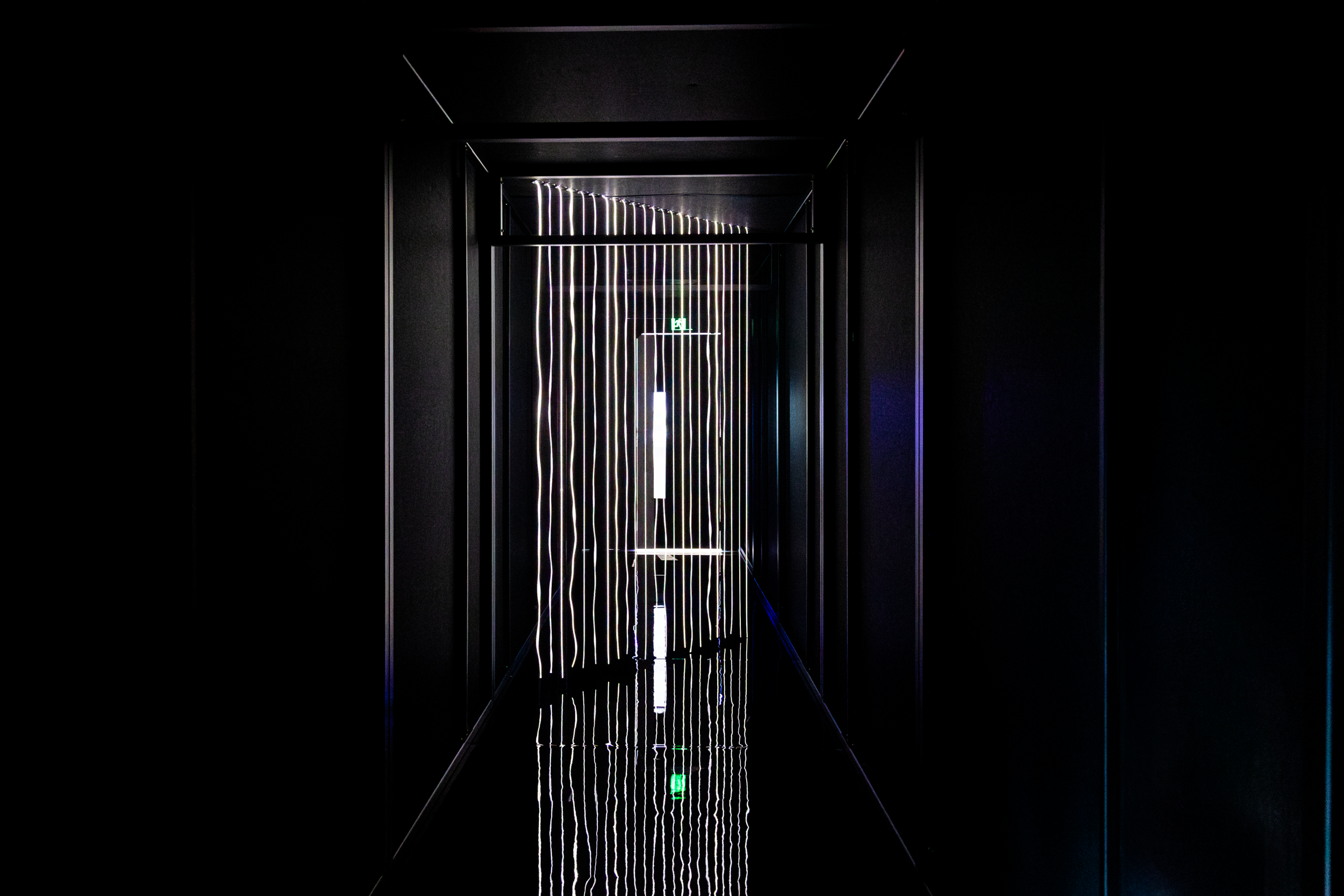A Deeper Look into Global Environments Through the Lens of Marc Vilanova’s ‘Cascade’ at BIENALSUR
Since its first edition in 2016, The International Contemporary Art Biennial of South America (BIENALSUR) traces a transnational narrative of simultaneous exhibitions and artistic projects that open up perspectives that reflect upon and develop contemporary humanism.
This year, its Buenos Aires venue, Museo de Arte Hispanoamericano Isaac Fernández Blanco, presents Catalan artist Marc Vilanova’s Cascade (2023), which is on display until December 31, 2023. Through this multisensory experience, Vilanova’s installation invites visitors to explore sonic dimensions that human beings cannot access, thus questioning the paradigm one uses to relate to the environment.
Cascade by Marc Vilanova in Science Gallery Melbourne's DARK MATTERS. Photography: Eloise Coomber, 2023.
As the only continuous source of infrasonic frequencies found in nature, the waterfall plays an essential role in Cascade. Its importance stems from how infrasonic frequencies (between 20 and 0.1 Hz) in this natural phenomenon are inaudible to the human species, who can only perceive sounds above 20 Hz. However, having this larger hearing range is essential to other species, such as birds. In this case, some birds use the infrasonic frequencies emitted by waterfalls, which can travel up to 250 miles, as a compass when migrating for long periods [1]. Their ability to perceive these infrasounds to locate and remember the emplacement of the waterfalls is essential for navigation. Today, however, noise pollution threatens the successful migration of birds, which become disoriented due to the perception of other artificial infrasonic waves originating from turbines and rotary engines. The consequences of climate change, such as the extreme drought in various parts of the globe, also nurture this confusion [2].
Cascade by Marc Vilanova at Headlands Center for the Arts, San Francisco. Photography: Romane Bladou, 2022.
Cascade reproduces a generative collage of infrasonic sounds recorded in Canadian waterfalls through 128 speakers that are too small to make these recordings audible. Despite their impotence, the speakers generate a vibration transmitted to a luminescent optical fibre. The result is a curtain of light that makes the presence of the sound waves crossing the fibre optic threads visible when the speakers try to reproduce infrasound. In addition, the frustrated effort of the amplifiers generates a static sound that, together with the rattling of the fibres against the floor, makes audible sounds that would otherwise not be audible to the human ear.
Through the artists’ collaboration with scientists, Vilanova's work physically realises the beat of a waterfall. In doing so, its link with the successful navigation of migratory birds becomes clear. Thus, taking in inorganic, artificial materials, the piece inaugurates a dialogue that recognises the reciprocity of existence on Earth and claims the ties that unite different forms of life on the basis of “feeling with” others, as proposed by anthropologist Tim Ingold.
Questioning the auditory and perceptual capacities of the human being decenters the human position as the “measure of all things”. It repositions it as part of an environment which outgrows humankind. By acknowledging the existence of other species usually perceived as inferior and the impact that human actions have on their life, Vilanova proposes a scientific investigation that, combined with a theoretical, conceptual, and artistic meditation on the new relational ontologies, leads to a creative reflection on the non-harmonic coexistence of sentient beings caused by the ever-increasingly anthropocentric dynamics.
This invites one to abandon the anthropocentric principle, based on extractivist and conquest principles, and instead pay attention to the unperceivable multiplicity of realities surrounding it. The variable pattern of the vibration brings into being a visual representation that, because of the unique and captivating forms generated, invites the audience to approach the curtain and touch it or cross it, inciting relationality. Flanked by a black curtain and displayed within a completely dark room, the interaction with the work is the only option left to the public. Such an exchange invites viewers to reflect on how they live and cohabit, in a rather disharmonious manner, with the rest of the creatures.
Cascade by Marc Vilanova at Espace 400e, Mois Multi, Quebec City. Photography: Charline Clavier, 2023.
Consequently, this affective rearrangement depends on a political and ethical repositioning that occurs when human beings experience their existence and life through the experience and struggle of other living beings [3]. In contact with the public's skin, Vilanova’s installation questions the ethical and moral position from which humans dismiss the consequences of their actions, such as industrial noise pollution, thus raising awareness of the capacity of their actions to affect other species [4].
Additionally, this sensitive interaction, which can be engaged through sight, hearing, movement, and touch, makes Cascade particularly inclusive and accessible for groups with functional diversity. As mentioned previously, Cascade appeals to the principle of “feeling with” others as the basis of social exchange, which is closely related to anthropologist Tim Ingold's ideas on social praxis [5]. Unlike semiotic and cognitive processes and approached from a practical and creative perspective, Ingold’s perspective approach avoids imposed pedagogies and the reproduction of unrestricted mobility patterns. So, by appealing to a feeling, viewers can engage with Cascade’s narrative just by perceiving the invisible energy derived from infrasound in a multisensorial manner, thus overcoming capacity.
Cascade by Marc Vilanova at Espace 400e, Mois Multi, Quebec City. Photography: Myriam Lambert, 2023.
In this way, Cascade triggers encounter, functioning on the basis of improvisation and materialising that which Ingold defines as entanglements of life: constant and open bonds that put the human species concerning the rest of sentient beings through experience and learning [6]. The anthropologist proposes that human socialisation is always intertwined with life in general, imbricated with the rest of living beings.
So, just like Ingold’s ideas, Cascade overcomes the tangible to point at the immaterial and incorporeal link that unites living beings. By stressing a systematic bias in the human capacity to acknowledge the value of other forms of life, it can be said that Cascade observes the existence of what Ingold calls “lifelines” that run parallel and interrelated in a “sensible ecology” [7].
Ultimately Cascade’s fibres shade light into both the position of the viewer within the room and its position within the world. This renewed awareness towards the viewer's position within an ecosystem of sentient beings acting within the world encapsulates the multiplicity of Cascade -- as an entity that allows for the passage of artistic and earthly knowledge.
Cascade by Marc Vilanova at Avatar, Quebec City. Photography: Alexandre Berthier, 2022.
This work was realised in part within the framework of the European Media Art Platform residency program at Gnration with the support of the Creative Europe Culture Programme of the European Union and Avatar Center, with the support of Fundació Ramon Llull.
Artist’s biography:
Marc Vilanova (Capellades, 1991) is a sound and visual artist working at the intersection of art, science, and technology. Vilanova’s artistic production has always been led by a spirit of innovation fueled by an interest in new media. His practice combines sound/light installations, performance, and sculpture. He has received numerous grants, awards, and residencies and his pieces have been presented in Japan, the U.S., Canada, Brazil, Colombia, Cuba, Iran, Argentina, Saudí Arabia, India, Taiwan, South Korea, Russia, and many countries in Europe.
Footnotes:
Zeyl, J. N., Ouden, O., Köppl, C., Assink, J., Christensen‐Dalsgaard, J., Patrick, S. C., & Clusella‐Trullas, S. (2020). Infrasonic hearing in birds: A review of audiometry and hypothesized structure–function relationships. Biological Reviews, 95(4), 1036–1054. https://doi.org/10.1111/brv.12596.
Bedard, A. J. (2021). Waterfall low-frequency vibrations and infrasound: Implications for avian migration and hazard detection. Journal of Comparative Physiology A, 207(6), 685–700. https://doi.org/10.1007/s00359-021-01510-5.
Bishop, C. (2006). Participation. Whitechapel.
Bishop, C. (2019). Installation art: A critical history. Tate Publishing.
Ingold, T. (2011). Being Alive: Essays on Movement, Knowledge and Description. Routledge, London, UK.
Ingold, T. (2008). Bindings against Boundaries: Entanglements of Life in an Open World. Environment and Planning A: Economy and Space, 40(8), 1796–1810. https://doi.org/10.1068/a40156.
Ingold, T. (2015). The Life of Lines. Routledge, London, UK.
Bibliography:
Bishop, C. (2019). Installation art: A critical history. Tate Publishing.
Laia Llobera
Contributing Writer, MADE IN BED










